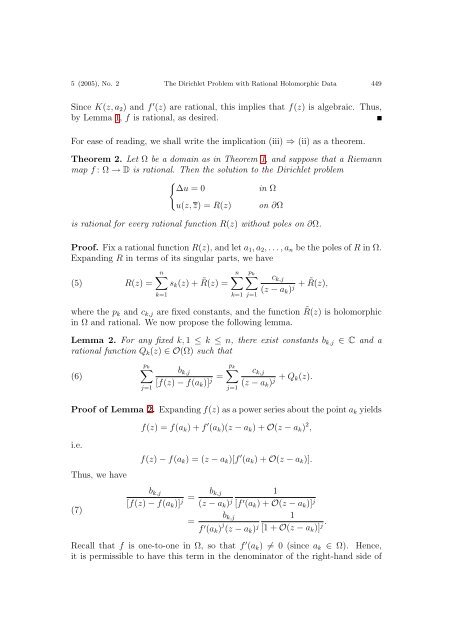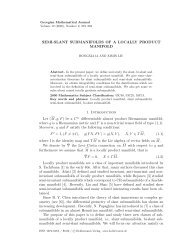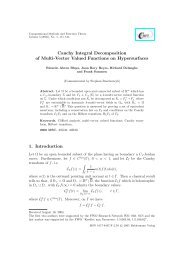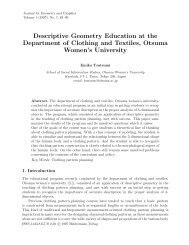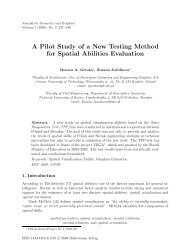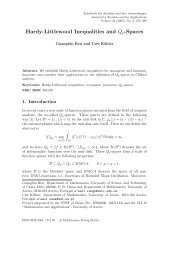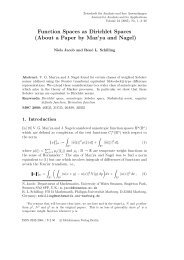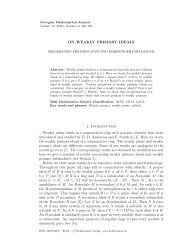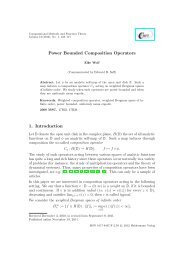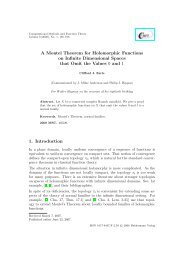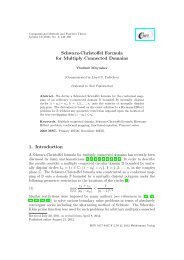On the Solution of the Dirichlet Problem with Rational Holomorphic ...
On the Solution of the Dirichlet Problem with Rational Holomorphic ...
On the Solution of the Dirichlet Problem with Rational Holomorphic ...
You also want an ePaper? Increase the reach of your titles
YUMPU automatically turns print PDFs into web optimized ePapers that Google loves.
5 (2005), No. 2 The <strong>Dirichlet</strong> <strong>Problem</strong> <strong>with</strong> <strong>Rational</strong> <strong>Holomorphic</strong> Data 449<br />
Since K(z, a 2 ) and f ′ (z) are rational, this implies that f(z) is algebraic. Thus,<br />
by Lemma 1, f is rational, as desired.<br />
For ease <strong>of</strong> reading, we shall write <strong>the</strong> implication (iii) ⇒ (ii) as a <strong>the</strong>orem.<br />
Theorem 2. Let Ω be a domain as in Theorem 1, and suppose that a Riemann<br />
map f : Ω → D is rational. Then <strong>the</strong> solution to <strong>the</strong> <strong>Dirichlet</strong> problem<br />
{<br />
∆u = 0 in Ω<br />
u(z, z) = R(z)<br />
on ∂Ω<br />
is rational for every rational function R(z) <strong>with</strong>out poles on ∂Ω.<br />
Pro<strong>of</strong>. Fix a rational function R(z), and let a 1 , a 2 , . . . , a n be <strong>the</strong> poles <strong>of</strong> R in Ω.<br />
Expanding R in terms <strong>of</strong> its singular parts, we have<br />
(5) R(z) =<br />
n∑<br />
s k (z) + ˜R(z) =<br />
k=1<br />
n∑<br />
p k<br />
∑<br />
k=1 j=1<br />
c k,j<br />
(z − a k ) j + ˜R(z),<br />
where <strong>the</strong> p k and c k,j are fixed constants, and <strong>the</strong> function ˜R(z) is holomorphic<br />
in Ω and rational. We now propose <strong>the</strong> following lemma.<br />
Lemma 2. For any fixed k, 1 ≤ k ≤ n, <strong>the</strong>re exist constants b k,j<br />
rational function Q k (z) ∈ O(Ω) such that<br />
(6)<br />
p k<br />
∑<br />
j=1<br />
p<br />
b k,j<br />
[f(z) − f(a k )] = ∑ k<br />
c k,j<br />
j (z − a k ) + Q k(z).<br />
j<br />
j=1<br />
∈ C and a<br />
Pro<strong>of</strong> <strong>of</strong> Lemma 2. Expanding f(z) as a power series about <strong>the</strong> point a k yields<br />
i.e.<br />
Thus, we have<br />
(7)<br />
f(z) = f(a k ) + f ′ (a k )(z − a k ) + O(z − a k ) 2 ,<br />
f(z) − f(a k ) = (z − a k )[f ′ (a k ) + O(z − a k )].<br />
b k,j<br />
[f(z) − f(a k )] = b k,j<br />
1<br />
j (z − a k ) j [f ′ (a k ) + O(z − a k )] j<br />
b k,j<br />
1<br />
=<br />
f ′ (a k ) j (z − a k ) j [1 + O(z − a k )] . j<br />
Recall that f is one-to-one in Ω, so that f ′ (a k ) ≠ 0 (since a k ∈ Ω). Hence,<br />
it is permissible to have this term in <strong>the</strong> denominator <strong>of</strong> <strong>the</strong> right-hand side <strong>of</strong>


